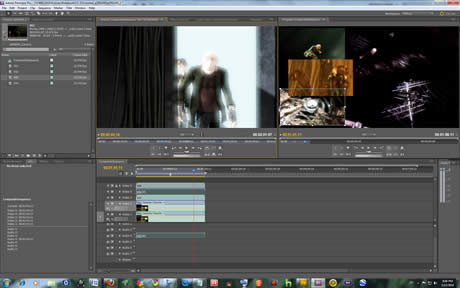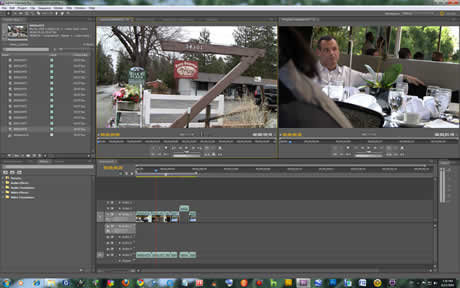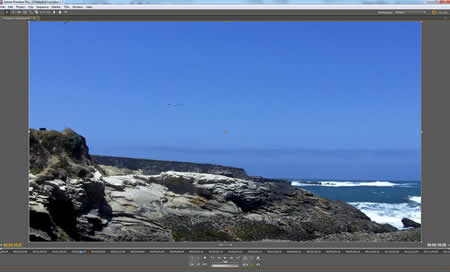 To find out what Adobe Premiere Pro CS5 offers filmmakers and film editors we had an interview with Karl Soule. Karl is a Technical Evangelist for Adobe Systems that promotes the use of Adobe’s video and audio tools to creative professionals, schools, and businesses in North America. You’ll find Karl on AdobeTV in the show “Short & Suite,” and at http://blogs.adobe.com/VideoRoad. Karl has recently started exploring DSLR filmmaking, and has a separate blog to discuss the Canon Rebel T2i and similar cameras. Karl can also be found on Twitter under KarlSoule.
To find out what Adobe Premiere Pro CS5 offers filmmakers and film editors we had an interview with Karl Soule. Karl is a Technical Evangelist for Adobe Systems that promotes the use of Adobe’s video and audio tools to creative professionals, schools, and businesses in North America. You’ll find Karl on AdobeTV in the show “Short & Suite,” and at http://blogs.adobe.com/VideoRoad. Karl has recently started exploring DSLR filmmaking, and has a separate blog to discuss the Canon Rebel T2i and similar cameras. Karl can also be found on Twitter under KarlSoule.
Bijan Tehrani: Is there any major difference between the 64-bit version and the 32-bit version of Adobe Premiere Pro CS5?
Karl Soule: Well, when it comes to Premiere Pro CS5 there is only a 64-bit version. If you compare the performance between the two versions you can see that the difference is huge. The only way you can compare 32-bit performance to 64-bit performance is that you would have to compare CS4 to CS5. With CS4 we had some tools in place for using additional memory. During the CS4 product cycle somebody noticed that if you were rendering your output files on a 64-bit output system that they were much faster to render. Now that we have moved to a completely 64-bit based control system in CS5, the performance increases are even faster. But the 64-bit is a requirement. There is no 32-bit performance for Premiere Pro CS5.
BT: So for the best performance of CS5 a user would have to use it on a 64-bit PC. What would be the MAC equivalent for that?
KS: Well, the nice thing about the MAC platform is that the MAC OS 10 is a 64-bit operating system, so MAC users do not have to worry about their operating system too much. We are recommending MAC 10.5.7 which is the Leopard release, or 10.6.3 which is the Snow Leopard release; both of those operating systems are supported.
BT: A lot of people are talking about the Mercury Playback Engine and how important it is. Can you tell us a little bit about it and how innovative it is for video editors? 
KS: The Mercury Playback Engine is a totally new experience and anyone who has used an earlier version of Premiere Pro really needs to see what it can do. Since the whole version is 64-bit native and optimized to use every core in the multicore system, those three features really just accelerate the performance beyond anything that anyone has seen before. I can do seven layers of HD footage, with chrome keying and color correction and I don’t have to render a single preview file to see the video playback in full resolution.
BT: What is the benefit for people that are Final Cut Pro users or use other editing software?
KS: The way that other Adobe applications work together has allowed a lot of interoperability. So not only do they get great editing performance, but they can import files from Photoshop and After Effects. There is very tight integration between Premiere Pro and After Effects, and I can edit from there. We have built into Premiere Pro the ability to work outside of the Adobe toolset. For Avid users we support AAF files for both input and output, which was actually used on the film Avatar. Since the Avid system was getting overloaded with files, they were able to import and store some of their Avid files in Premiere Pro. The same is true of Final Cut Pro; users can import and export XML files. We have some customers that do more finishing with Premiere Pro and they import and export their proxy files in After Effects which helps produce a better looking film. Premiere Pro is a very nice tool that can help advance various workflows.
BT: One of the amazing things is how CS5 deals with different file formats especially in HD. Can you please explain how the software deals with different HD file formats?
KS: Sure. With Premiere Pro we have taken a philosophy of working natively with footage directly from cameras. We have a system where you can edit directly off of the memory card from many different types of camers formats such as XD Cam, XD Cam EX, Panasonic AVC intra and DVC Pro HD, the Red ONE Camera, and now with CS5 we have support from the higher resolution chip from RED. So now we have a system that reads many different file structures, which prevents us from going in and out of many different folders. Many of these new tapeless cameras have very specific directories where you have to keep the files, so our system makes it much easier for someone editing to find the files and edit them natively. Transcoding and rewrapping the files is now very easy because you can work directly off of the camera.
 BT: Many young filmmakers have started to use consumer cameras to use HD, and the quality appears to be acceptable. How does CS5 deal with those kinds of files?
BT: Many young filmmakers have started to use consumer cameras to use HD, and the quality appears to be acceptable. How does CS5 deal with those kinds of files?
KS: AVC HD is a certain format that uses a very heavy form of compression, and this uses a lot of CPU horsepower to transcode HD footage. With CS5 moving to multicore optimization, anyone who works with AVC HD is going to see a huge jump forward in the performance that they see when compared to CS4. AVC HD is a great example of a codec that really needed to move into a 64-bit space and so the performance gains you will see are numerous, and the playback has drastically changed in CS5. Color correcting and adjusting footage is again much easier, and your entire playback is done without rendering.
BT: Are there any new features or changes made to Chroma Keying in CS5?
KS: For Chroma Keying in CS5, we have added a new effect called the Ultra Key. It is different than Chroma Keying, called vector keying. This originally lived in a program called Ultra that we had as a separate utility program in CS3. The way vector keying works is that it actually goes through and does some work rebuilding color information inside of the file. So footage that has gone through a lot of compression such as HD footage and even standard definition footage like DV, will not give you the jaggy edges that are associated with that kind of keying. You can edit these right on the timeline as opposed to going into After Affects. The system is GSU accelerated as well, so it’s one of over 30 effects that is accelerated in CS5.
BT: You also mentioned that the native support for the SLR cameras is something that users have been asking for. How important is this for the filmmaking community?
KS: I think that the amount of growth that we have seen with the SLR camera is huge. The quality of the footage is great and provides a wide range of latitude. With Premiere Pro we have created specific presets that allow users to work right off of the camera. We have created a new preset called 30p at 29.97 and this takes advantage of the fact that Premiere Pro can use footage at different frame rates and time lines. So you can actually take footage from two different types of cameras and edit them together on the timeline.
BT: Please tell us how Adobe Story and Adobe OnLocation work with Premiere Pro CS5.
KS: What we have been working on is making new ways to improve workflows throughout the entire editing process. With CS5 we have introduce a new tool called Adobe Story, which is a tool that enables screenwriting, but also lets you take any screenplay and ingest it into the system. The system will help you name clips, so that they are not esoteric. With the process you can actually pull the scene names and the shot names and add them to the script. We can use the dialogue in the shots and combine that with a tool we have in Premiere Pro and get dialogue matches with words that are spoken and in the shooting script. So you can set marker points on your video throughout your script and jump to a point in the video by finding words in your script. We’re also working with search engines such as Google, which makes the software tools more accessible.
into the system. The system will help you name clips, so that they are not esoteric. With the process you can actually pull the scene names and the shot names and add them to the script. We can use the dialogue in the shots and combine that with a tool we have in Premiere Pro and get dialogue matches with words that are spoken and in the shooting script. So you can set marker points on your video throughout your script and jump to a point in the video by finding words in your script. We’re also working with search engines such as Google, which makes the software tools more accessible.
BT: How is the integration of Premiere Pro and CS5?
KS: A lot of the integration between Premiere Pro and the other tools is all under the heading of something that we call Adobe Dynamic Link. Dynamic Link is a product that has its own separate engineering team and it is really the glue that ties all of the different Adobe tools together. For instance, taking a composition in After Effects and dropping it right on the timeline in Premiere Pro, all of that technology falls under Dynamic Link. For CS5 we have written Dynamic Link to be purely 64-bit native which allows the program to access more RAM. With CS5, customers are going to see better playback and an overall increase in the way the performance works.
BT: Do you think that CS5 will revolutionize the world of editing?
KS: I think that the system will address a lot of problems that users are having in their productions. Not only is the footage playable directly off of the camera, but users have a whole new series of real-time tools to use in order to edit their footage. We don’t want to force anyone to make any changes but we are seeing people become more interested in our software and are really excited about the performance gain. People are very ,very happy with the stability and the performance, and it has been a great experience showing people the program and seeing their excitement about it.

